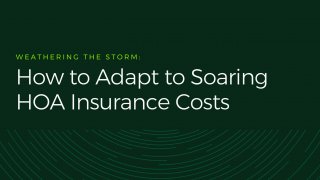- January 16, 2024
- CINC Systems

Survey responses for CINC’s upcoming 2024 State of the Industry Report are pouring in. If one thing is evident from the early results, 2024 will be a year of change for the association management industry. As HOA management companies and boards report increasing concerns around client turnover, deferred maintenance, rising insurance costs, and other issues, improving efficiency and thinking outside the box will be key to profitability.
Adam Balkcom is the CEO of CAM Leadership Institute (CLI), a community of management company leaders and industry experts offering mastermind groups, coaching, tools, accountability, and more to help companies overcome their greatest challenges. We spoke to Adam to find out his predictions for 2024 based on CLI members’ top concerns and priorities. Here are the top four.
Technology has become more integral.
Many community managers responding to our State of the Industry survey said they believe homeowner self-service tools are vital to advancing their careers. Adam believes there has long been a disconnect between the role managers should be playing and the tasks that consume most of their time.
“When you think about the role the community manager should play, they should be interfacing with the board and handling more complex projects and issues,” he says. “They shouldn’t be handling simple homeowner requests.”
While there has been plenty of industry buzz around efficiency-driving tools like outsourcing, automation, and AI tools in recent years, he believes next year will see more companies fully leveraging these solutions to handle high-volume, low-complexity tasks, which could lower costs while allowing managers more time for higher-level projects.
“2023 was the year to tinker with these new tools,” he explains. “2024 is the year to fully integrate them into the company to see cost savings and bring reprieve to overwhelmed team members.”
The industry is getting serious about data and cybersecurity.
While technology like AI can boost efficiency and the bottom line, it can also threaten data security by giving bad actors more sophisticated tools to find and exploit vulnerabilities.
“One of our advanced group members, a large management company, was talking about hackers trying to get into their check scanners,” Adam says. “I think creative cyber-attacks like this are only going to grow, and that’s going to become a bigger topic.”
He explains that the industry also needs more standardized data and performance indicators to benchmark, measure, and make better business decisions.
“Across our membership, only about 20% of our companies are actually surveying the boards. And it’s very rudimentary. They mail them a form, or they do a Google form, but it’s not standardized. It’s pretty subjective.”
He hopes to see the industry move towards more standardized P&Ls to enable comparative data. “That’s really been a struggle. Everybody’s P&Ls are so different which makes it challenging to get consistent bench-marking data.”
Management companies tighten their contracts.
Many small to medium-sized management companies currently struggle with profitability, like one business owner in a CLI group Adam spoke of who was close to selling her company — until she began charging fees for the additional services her company was already providing.
“She called me last week and said, ‘I just received $20K from a board for a loan administration fee. I’ve done this a million times with boards and never charged for it,’” he recalls.
He believes revisiting contracts will be a top priority for companies with similar challenges, starting with defining what’s included in the base management fee and what isn’t.
“We are seeing a big move away from all-inclusive management fees. Most companies are now including everything that is predictable and ongoing as part of the base management fee,” He says.
“Things that are unpredictable, like a major project, having to get a loan, having to do an assessment, or having to make a big insurance claim, are not baked into the base management fee.”
Making these contractual changes could produce dramatic results for companies’ bottom lines in the short and long term. Consider the example of the owner who quickly boosted revenue simply by charging loan administration fees.
“She could bonus her people more at the end of the year than someone who didn’t have that,” Adam explains. “That money drives up profitability and makes more money available to improve and grow the business.”
Communities start running more like businesses.
The bad news is that insurance costs aren’t coming down, at least not anytime soon. But association management industry professionals and HOA boards are getting increasingly creative to offset rising costs. Adam says he’s seen some management companies using innovative strategies like group insurance to decrease rates, or even being able to get better rates through partnerships as a selling point to get boards to switch to their management company.
To maintain their communities without depleting reserves, Adam explains, more HOA boards will have to make the tough decision to increase dues. He also believes boards will start to find new revenue streams by monetizing their unique access to residents through exclusive agreements with service providers and more.
“Communities are going to have to start running a lot more like businesses and finding other revenue streams to offset the impact of rising insurance and rising costs of infrastructure, especially if they are not wanting to raise dues,” he predicts.
We look forward to bringing you more insights in our 2024 State of the Industry Report! Please stay tuned, and be sure to follow CINC Systems on LinkedIn.
Related Reads

Blog
Keeping Calm and Carrying On: Leadership Tips for Turbulent Times
- November 20, 2024

Blog
AI at Bat: What Umpires, Baseball, and Data Security Can Teach Us About AI Risks
- October 28, 2024

Blog
Do I really need a homeowner app when I have a mobile-friendly website?
- October 14, 2024

Blog
Weathering the Storm: How to Adapt to Soaring HOA Insurance Costs
- October 1, 2024

Blog
How Today’s Generative AI Investment Drives Long-Term CAM Success: A Timeline
- September 16, 2024

Blog
A Common Sense Approach to Simplifying Budget Planning Get ready to conquer HOA budget season with this effective strategy
- September 2, 2024
